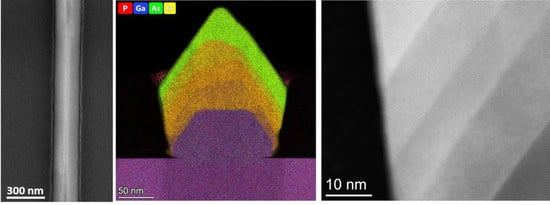Selective-Area Epitaxy of InGaAsP Buffer Multilayer for In-Plane InAs Nanowire Integration
Abstract
:1. Introduction
2. Materials and Methods
3. Results and Discussion
4. Conclusions
Supplementary Materials
Author Contributions
Funding
Institutional Review Board Statement
Informed Consent Statement
Data Availability Statement
Acknowledgments
Conflicts of Interest
References
- Oreg, Y.; Refael, G.; Von Oppen, F. Helical Liquids and Majorana Bound States in Quantum Wires. Phys. Rev. Lett. 2010, 105, 177002. [Google Scholar] [CrossRef] [Green Version]
- Aseev, P.; Fursina, A.; Boekhout, F.; Krizek, F.; Sestoft, J.E.; Borsoi, F.; Heedt, S.; Wang, G.; Binci, L.; Marti-Sanchez, S.; et al. Selectivity Map for Molecular Beam Epitaxy of Advanced III–V Quantum Nanowire Networks. Nano Lett. 2019, 19, 218–227. [Google Scholar] [CrossRef]
- Hertel, A.; Andersen, L.O.; Van Zanten, D.M.T.; Eichinger, M.; Scarlino, P.; Yadav, S.; Karthik, J.; Gronin, S.; Gardner, G.C.; Manfra, M.J.; et al. Electrical Properties of Selective-Area-Grown Superconductor-Semiconductor Hybrid Structures on Silicon. Phys. Rev. Appl. 2021, 16, 044015. [Google Scholar] [CrossRef]
- Gooth, J.; Borg, M.; Schmid, H.; Schaller, V.; Wirths, S.; Moselund, K.; Luisier, M.; Karg, S.; Riel, H. Ballistic One-Dimensional InAs Nanowire Cross-Junction Interconnects. Nano Lett. 2017, 17, 2596–2602. [Google Scholar] [CrossRef] [PubMed]
- Friedl, M.; Cerveny, K.; Weigele, P.; Tütüncüoglu, G.; Martí-Sánchez, S.; Huang, C.; Patlatiuk, T.; Potts, H.; Sun, Z.; Hill, M.O.; et al. Template-Assisted Scalable Nanowire Networks. Nano Lett. 2018, 18, 2666–2671. [Google Scholar] [CrossRef]
- Park, J.S.; Tang, M.; Chen, S.; Liu, H. Heteroepitaxial Growth of III-V Semiconductors on Silicon. Crystals 2020, 10, 1163. [Google Scholar] [CrossRef]
- Wright, S.L.; Inada, M.; Kroemer, H. Polar-on-Nonpolar Epitaxy: Sublattice Ordering in the Nucleation and Growth of GaP on Si(211) Surfaces. J. Vac. Sci. Technol. 1982, 21, 534–539. [Google Scholar] [CrossRef]
- Wright, S.L.; Kroemer, H.; Inada, M. Molecular Beam Epitaxial Growth of GaP and GaAs1-XPx. J. Alloys Compd. 1983, 55, 337–347. [Google Scholar] [CrossRef]
- Volz, K.; Beyer, A.; Witte, W.; Ohlmann, J.; Nmeth, I.; Kunert, B.; Stolz, W. GaP-Nucleation on Exact Si (0 0 1) Substrates for III/V Device Integration. J. Cryst. Growth 2011, 315, 37–47. [Google Scholar] [CrossRef]
- Desplanque, L.; El Kazzi, S.; Coinon, C.; Ziegler, S.; Kunert, B.; Beyer, A.; Volz, K.; Stolz, W.; Wang, Y.; Ruterana, P.; et al. Monolithic Integration of High Electron Mobility InAs-Based Heterostructure on Exact (001) Silicon Using a GaSb/GaP Accommodation Layer. Appl. Phys. Lett. 2012, 101, 1–5. [Google Scholar] [CrossRef]
- Liu, A.Y.; Bowers, J. Photonic Integration with Epitaxial III-V on Silicon. IEEE J. Sel. Top. Quantum Electron. 2018, 24, 1–12. [Google Scholar] [CrossRef]
- Fahed, M.; Desplanque, L.; Troadec, D.; Patriarche, G.; Wallart, X. Threading Dislocation Free GaSb Nanotemplates Grown by Selective Molecular Beam Epitaxy on GaAs (001) for in-Plane InAs Nanowire Integration. J. Cryst. Growth 2017, 477, 45–49. [Google Scholar] [CrossRef]
- Krizek, F.; Sestoft, J.E.; Aseev, P.; Marti-Sanchez, S.; Vaitiekenas, S.; Casparis, L.; Khan, S.A.; Liu, Y.; Stankevič, T.; Whiticar, A.M.; et al. Field Effect Enhancement in Buffered Quantum Nanowire Networks. Phys. Rev. Mater. 2018, 2, 093401. [Google Scholar] [CrossRef] [Green Version]
- Glas, F. Critical Dimensions for the Plastic Relaxation of Strained Axial Heterostructures in Free-Standing Nanowires. Phys. Rev. B 2006, 74, 121302. [Google Scholar] [CrossRef]
- Caroff, P.; Messing, M.E.; Mattias Borg, B.; Dick, K.A.; Deppert, K.; Wernersson, L.E. InSb Heterostructure Nanowires: MOVPE Growth under Extreme Lattice Mismatch. Nanotechnology 2009, 20, 495606. [Google Scholar] [CrossRef]
- Ercolani, D.; Rossi, F.; Li, A.; Roddaro, S.; Grillo, V.; Salviati, G.; Beltram, F.; Sorba, L. InAs/InSb Nanowire Heterostructures Grown by Chemical Beam Epitaxy. Nanotechnology 2009, 20, 505605. [Google Scholar] [CrossRef]
- Tomioka, K.; Tanaka, T.; Hara, S.; Hiruma, K.; Fukui, T. III-V Nanowires on Si Substrate: Selective-Area Growth and Device Applications. IEEE J. Sel. Top. Quantum Electron. 2011, 17, 1112–1129. [Google Scholar] [CrossRef]
- Aseev, P.; Wang, G.; Binci, L.; Singh, A.; Martí-Sánchez, S.; Botifoll, M.; Stek, L.J.; Bordin, A.; Watson, J.D.; Boekhout, F.; et al. Ballistic InSb Nanowires and Networks via Metal-Sown Selective Area Growth. Nano Lett. 2019, 19, 9102–9111. [Google Scholar] [CrossRef] [PubMed] [Green Version]
- Fahed, M.; Desplanque, L.; Troadec, D.; Patriarche, G.; Wallart, X. Selective Area Heteroepitaxy of GaSb on GaAs (001) for in-Plane InAs Nanowire Achievement. Nanotechnology 2016, 27, 505301. [Google Scholar] [CrossRef] [PubMed]
- Lee, J.S.; Choi, S.; Pendharkar, M.; Pennachio, D.J.; Markman, B.; Seas, M.; Koelling, S.; Verheijen, M.A.; Casparis, L.; Petersson, K.D.; et al. Selective-Area Chemical Beam Epitaxy of in-Plane InAs One-Dimensional Channels Grown on InP(001), InP(111)B, and InP(011) Surfaces. Phys. Rev. Mater. 2019, 3, 084606. [Google Scholar] [CrossRef] [Green Version]
- Schmid, H.; Borg, M.; Moselund, K.; Gignac, L.; Breslin, C.M.; Bruley, J.; Cutaia, D.; Riel, H. Template-Assisted Selective Epitaxy of III-V Nanoscale Devices for Co-Planar Heterogeneous Integration with Si. Appl. Phys. Lett. 2015, 106, 233101. [Google Scholar] [CrossRef]
- Tutuncuoglu, G.; De La Mata, M.; Deiana, D.; Potts, H.; Matteini, F.; Arbiol, J.; Fontcuberta, I. Morral, A. Towards Defect-Free 1-D GaAs/AlGaAs Heterostructures Based on GaAs Nanomembranes. Nanoscale 2015, 7, 19453–19460. [Google Scholar] [CrossRef]
- Desplanque, L.; Bucamp, A.; Troadec, D.; Patriarche, G.; Wallart, X. Selective Area Molecular Beam Epitaxy of InSb Nanostructures on Mismatched Substrates. J. Cryst. Growth 2019, 512, 6–10. [Google Scholar] [CrossRef]
- Davies, G.J.; Duncan, W.J.; Skevington, P.J.; French, C.L.; Foord, J.S. Selective Area Growth for Opto-Electronic Integrated Circuits (OEICs). Mater. Sci. Eng. B 1991, 9, 93–100. [Google Scholar] [CrossRef]
- Chin, A.; Martin, P.; Das, U.; Mazurowski, J.; Ballingall, J. Chemical Beam Epitaxial Growth of InP, InGaP, and InAs Heterojunctions Using Triethylindium and Bisphosphinoethane. J. Vac. Sci. Technol. B Microelectron. Nanom. Struct. 1993, 11, 847. [Google Scholar] [CrossRef]
- Freundlich, A.; Bensaoula, A.H.; Bensaoula, A. Growth of InAs/InP and InAsP/InP Heterostructures by Chemical Beam Epitaxy. J. Cryst. Growth 1993, 127, 246–250. [Google Scholar] [CrossRef]
- Vogt, T.J.; Thiagarajan, P.; Robinson, G.Y. Molecular Beam Epitaxy Growth of InGaP Multiple Quantum Well Structures on GaP for Optical Modulators. J. Vac. Sci. Technol. B Microelectron. Nanom. Struct. 1996, 14, 2248–2251. [Google Scholar] [CrossRef]
- Moll, N.; Scheffler, M.; Pehlke, E. Influence of Surface Stress on the Equilibrium Shape of Strained Quantum Dots. Phys. Rev. B. 1998, 58, 4566–4571. [Google Scholar] [CrossRef] [Green Version]
- Hurle, D.T.J. A Mechanism for Twin Formation during Czochralski and Encapsulated Vertical Bridgman Growth of III-V Compound Semiconductors. J. Cryst. Growth 1995, 147, 239–250. [Google Scholar] [CrossRef]
- Shapiro, J.N.; Lin, A.; Ratsch, C.; Huffaker, D.L. Temperature Dependence of Stacking Faults in Catalyst-Free GaAs Nanopillars. Nanotechnology 2013, 24, 475601. [Google Scholar] [CrossRef]
- Johansson, J.; Karlsson, L.S.; Svensson, C.P.T.; Mårtensson, T.; Wacaser, B.A.; Deppert, K.; Samuelson, L.; Seifert, W. Structural Properties of <111>B -Oriented III-V Nanowires. Nat. Mater. 2006, 5, 574–580. [Google Scholar] [CrossRef] [PubMed]
- Grillo, V.; Rossi, F. STEM_CELL: A software tool for electron microscopy. Part 2 analysis of crystalline materials. Ultramicroscopy 2013, 125, 112–129. [Google Scholar] [CrossRef]
- Arif, O.; Zannier, V.; Li, A.; Rossi, F.; Ercolani, D.; Beltram, F.; Sorba, L. Growth and Strain Relaxation Mechanisms of InAs/InP/GaAsSb Core-Dual-Shell Nanowires. Cryst. Growth Des. 2020, 20, 1088–1096. [Google Scholar] [CrossRef]
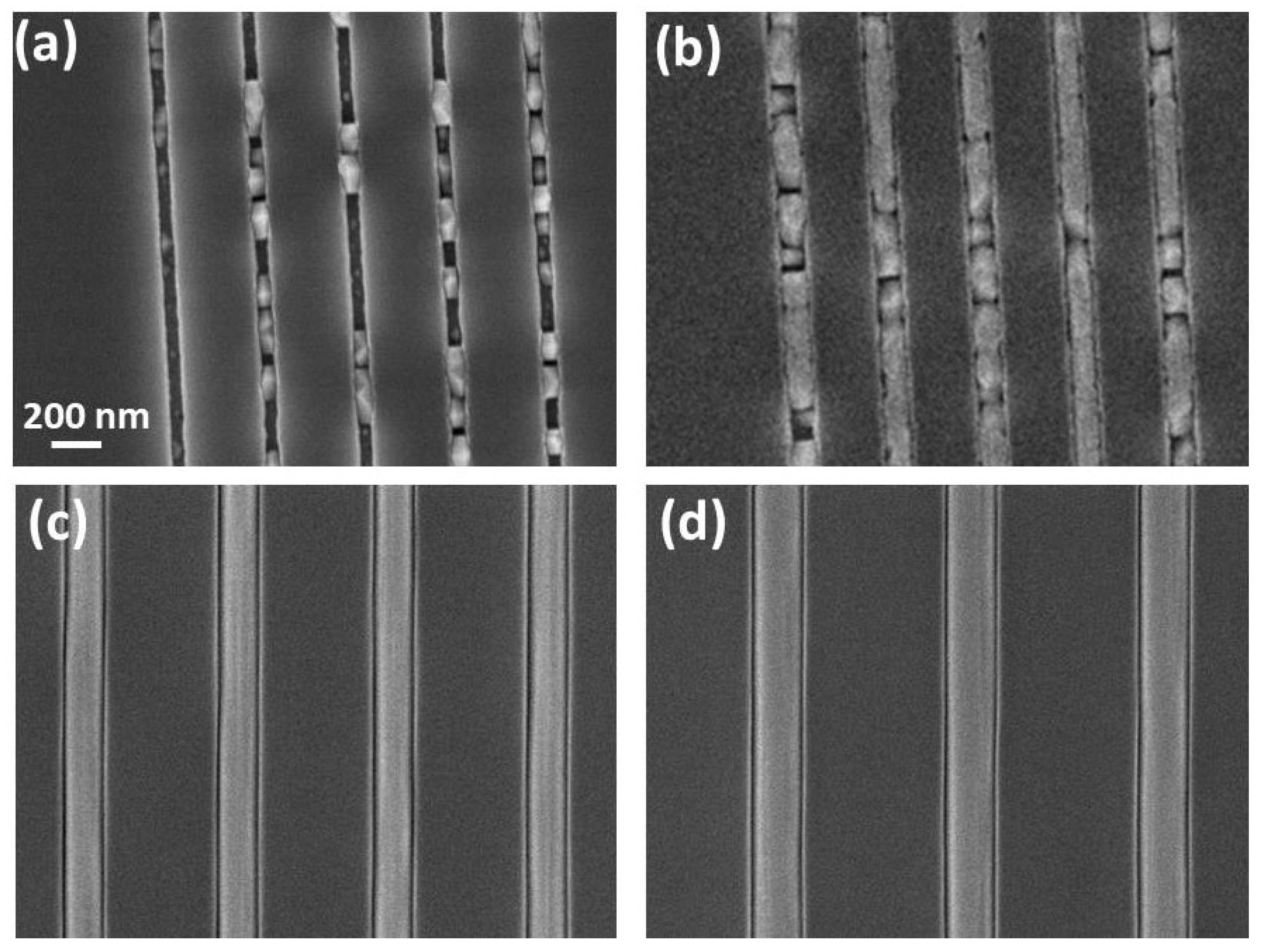
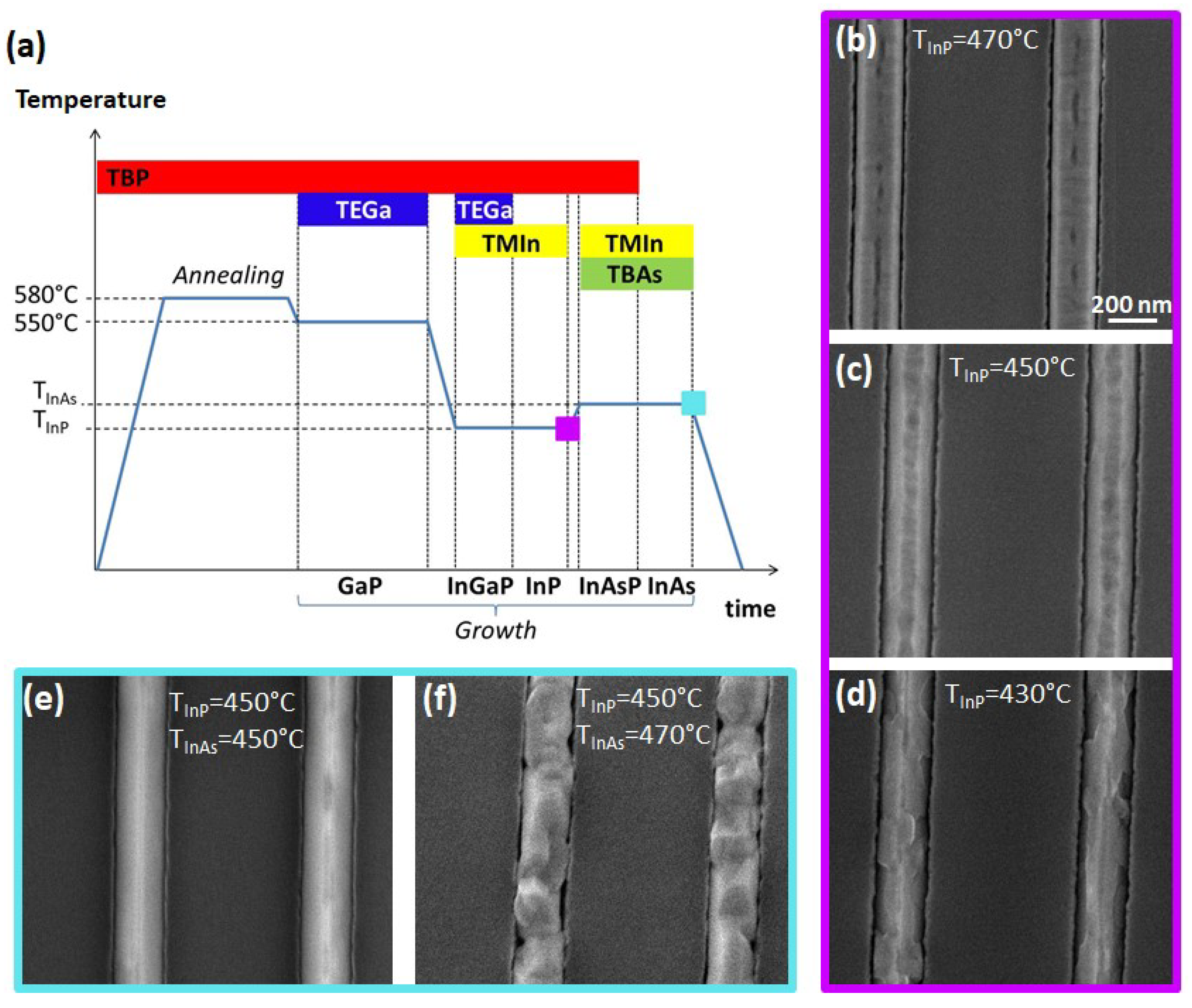
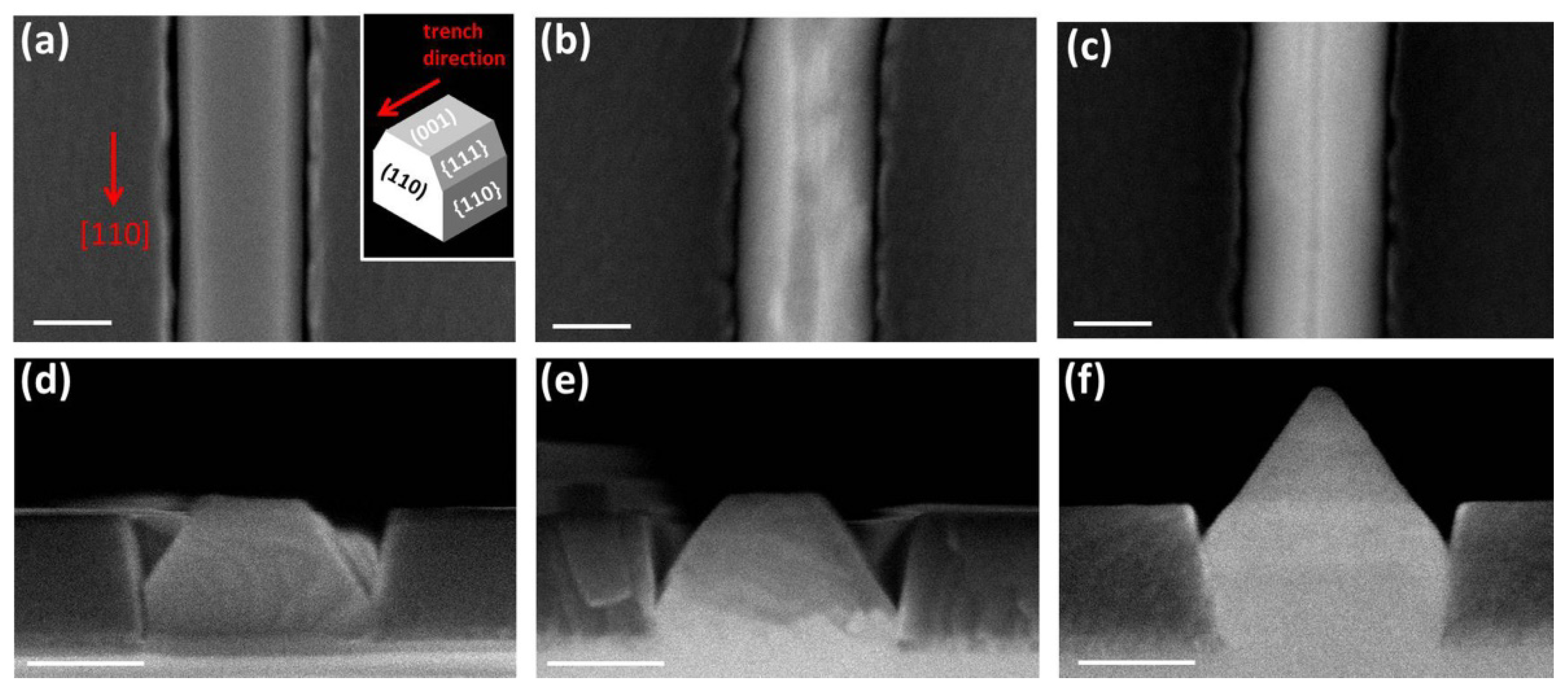


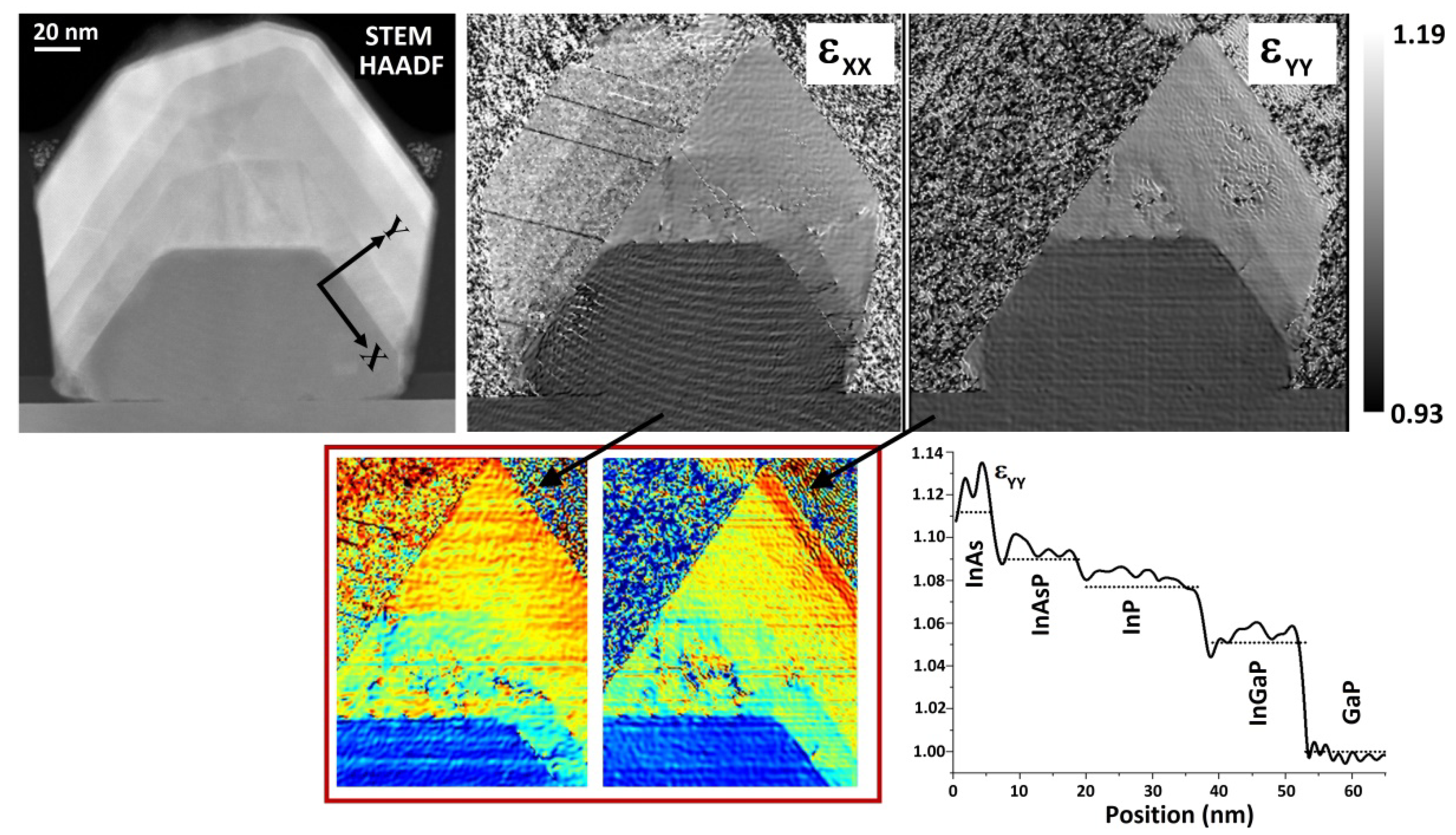
Publisher’s Note: MDPI stays neutral with regard to jurisdictional claims in published maps and institutional affiliations. |
© 2022 by the authors. Licensee MDPI, Basel, Switzerland. This article is an open access article distributed under the terms and conditions of the Creative Commons Attribution (CC BY) license (https://creativecommons.org/licenses/by/4.0/).
Share and Cite
Zannier, V.; Li, A.; Rossi, F.; Yadav, S.; Petersson, K.; Sorba, L. Selective-Area Epitaxy of InGaAsP Buffer Multilayer for In-Plane InAs Nanowire Integration. Materials 2022, 15, 2543. https://doi.org/10.3390/ma15072543
Zannier V, Li A, Rossi F, Yadav S, Petersson K, Sorba L. Selective-Area Epitaxy of InGaAsP Buffer Multilayer for In-Plane InAs Nanowire Integration. Materials. 2022; 15(7):2543. https://doi.org/10.3390/ma15072543
Chicago/Turabian StyleZannier, Valentina, Ang Li, Francesca Rossi, Sachin Yadav, Karl Petersson, and Lucia Sorba. 2022. "Selective-Area Epitaxy of InGaAsP Buffer Multilayer for In-Plane InAs Nanowire Integration" Materials 15, no. 7: 2543. https://doi.org/10.3390/ma15072543
APA StyleZannier, V., Li, A., Rossi, F., Yadav, S., Petersson, K., & Sorba, L. (2022). Selective-Area Epitaxy of InGaAsP Buffer Multilayer for In-Plane InAs Nanowire Integration. Materials, 15(7), 2543. https://doi.org/10.3390/ma15072543






